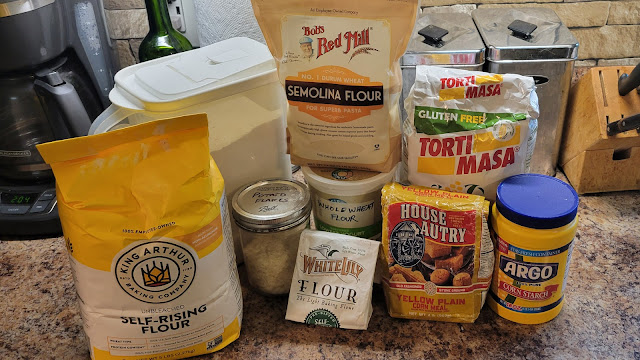Many of the
recipes I’ve shared in my posts involve some form of flour. At a basic level, flour is the ground product of
any of a number of grains, beans, nuts, roots, or seeds. Humans have
been grinding all sorts of plants to a fine powder for at least eight thousand
years, though there’s some evidence it may go back much earlier in our
development.
The biggest
issue with long-term storage of flour, as with so many things, is oxygen. If
the germ of the grain is left in during production of flour, the fatty acids present start
to oxidize immediately, leading to spoilage. This high
risk of spoilage led to the prevalence on the market of white wheat flour,
which is basically whole wheat flour with the germ and bran removed. In fact, most wheat
flour is processed as white flour, and then the germ is added back in after it’s
treated for preservation, producing whole wheat flour.
Currently in
the United States, the most common flour is made from wheat. Following that, corn is the next most popular
source, and even these basic categories have a number of varieties. However, almond,
various bean, buckwheat, chickpea, hazelnut, peanut, potato, rice, tapioca, and
many other flours can be found in the baking aisle of many grocery and specialty
stores.
It’s not
uncommon in the baking aisle to see packages of flour labelled all-purpose,
bread, biscuit, cake, enriched, pastry, self-rising, unbleached, and whole
wheat. These divisions are generally based on the fineness of the grind as well
as additives or supplements in the mix, though some labels are more for
advertising purposes.
A selection of flours and friends from
the author’s pantry.
L-R: Self-rising white; regular white; potato flakes; Semolina;
whole wheat; White Lily soft wheat; corn Masa; corn meal; corn starch.
The most
common uses of flour are for making things like bread, pasta, cookies, cakes,
and as additives in a wide variety of other foods. For example, when making a
roux to thicken gravy and sauces, some form of flour is essential to produce
the proper consistency. In non-food
use, when mixed with water and a little salt, flour is an essential ingredient
in papier-mâché or wallpaper paste. It can also be used to make a sort of clay
for children’s projects.
While it’s certainly possible to get un-milled grain and run it through a manual or electric mill, that’s a pretty significant investment in time and money. Most preppers are likely better off buying pre-milled flour in bulk and storing it in food-safe airtight containers with oxygen
absorbers. Larger quantities can be kept in buckets, and smaller amounts in Mylar
bags. In our house, we tend to store some flour in canning jars and zip lock bags because we have
them conveniently at hand.
While there
is some overlap between types and styles, it’s important to use the right flour
for the job. Coarseness, density, water retention and other factors will
determine how a particular flour affects a recipe. As they say, "Horses for courses."
Good
prepping, and good cooking.



No comments:
Post a Comment